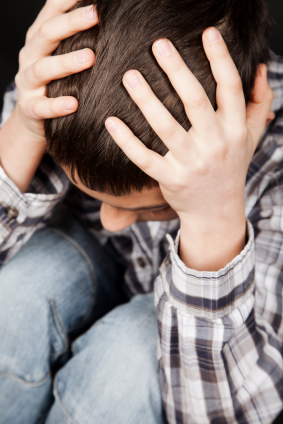Treating Bipolar Depression in Youth
 At the Ryan Licht Sang pediatric bipolar conference in March, researcher Karen Dineen Wagner summarized the controlled data on treatment of bipolar depression in children. Almost no data exist, with the exception of one study in which quetiapine (Seroquel) was not found to be more effective than placebo.
At the Ryan Licht Sang pediatric bipolar conference in March, researcher Karen Dineen Wagner summarized the controlled data on treatment of bipolar depression in children. Almost no data exist, with the exception of one study in which quetiapine (Seroquel) was not found to be more effective than placebo.
Unlike mania, for which there are several approved treatments for children aged 10 to 17, there are no FDA-approved treatments for bipolar depression in children.
In adults, quetiapine is the only approved monotherapy for bipolar depression, and the only other approved treatment is the combination of fluoxetine and olanzapine. Despite the frequency with which conventional antidepressants (SSRIs, SNRIs, bupropion, and tricyclic antidepressants) are prescribed for bipolar depression, the data on their efficacy is mostly negative, based on a 2010 meta-analysis by researchers Sidor and MacQueen.
Given that there is little data available even for adults, Wagner reviewed the open (uncontrolled) studies on depression in children with bipolar disorder. Some evidence of good response to lithium or lamotrigine can be found in case series and chart reviews. In studies of atypical antipsychotics for mania in children, the mania rating scales used contain items about depression, and these often show some improvement.
Wagner concluded that one option is to use monotherapy with atypicals, lithium, or lamotrigine in children with bipolar depression.
Wagner created a revised Mood Disorder Questionnaire for Adolescents (MDQ-A), which focuses on a possible diagnosis of bipolar disorder instead of unipolar depression. This was published in the Journal of Clinical Psychiatry in 2006 and we have reproduced it here. Dr. Wagner indicated that the instrument is more valid when the answers are supplied by a parent than by the adolescent.
Editor’s Note: The lack of research on the treatment of children with bipolar disorder is a public health problem. Read more
New Data Support the Efficacy of Lurasidone for Bipolar Depression
In two recent clinical trials that were presented at the annual meeting of the American Psychiatric Association in May 2012, the atypical antipsychotic lurasidone (Latuda), which is currently used to treat schizophrenia, was associated with significant improvement in bipolar depression compared to placebo. The studies, known as PREVAIL (or Program to Evaluate the Antidepressant Impact of Lurasidone), assessed lurasidone’s efficacy as an adjunctive treatment and as a monotherapy.
PREVAIL 1 assessed lurasidone’s efficacy and safety when the drug was added to treatment with lithium or valproate in bipolar patients who became depressed. In this 6-week study, scores on the Montgomery-Asberg Depression Rating Scale (MADRS) improved significantly more in patients taking lurasidone (20 – 120mg/day; N=183) in addition to their mood stabilizer compared to those who received placebo (N=165) in addition to their mood stabilizer.
In PREVAIL 2, patients received lurasidone at either 20-60mg/day (N=166) or 80-120mg/day (N=169) or placebo (N=170) as a monotherapy for bipolar depression. As measured by MADRS scores, lurasidone was significantly more effective in improving bipolar depression than placebo was by the end of the 6-week study period.
In both studies lurasidone showed significant effects on other measures and endpoints including: improvement in Clinical Global Impressions severity of depression (CGI-BP-S) scores, reductions in anxiety symptoms, and improvement in social or occupational functioning. Lurasidone also produced higher rates of response (50% improvement on the MADRS). The CGI-BP-S improved in patients on lurasidone significantly more than in those on placebo as early as week one.
Editor’s Note: These two trials in bipolar depression suggest new possibilities for treating the depressed phase of bipolar disorder.
In studies of patients with schizophrenia, lurasidone has had an excellent safety and tolerability profile; it is relatively weight neutral and does not increase metabolic indices such cholesterol, triglycerides, or blood sugar.
Lurasidone also has an unusual mechanism of action, blocking serotonin 5HT 7 receptors, that may be related to its antidepressant effects. Antagonism of 5HT 7 receptors has been closely linked to antidepressant effects in studies of animal models of depression by two different investigators, Stephen Stahl and Herb Meltzer. It remains to be seen whether this or some other mechanism of lurasidone accounts for its antidepressant effects.
As we have noted before, since all antipsychotic drugs used in the treatment of schizophrenia (which block dopamine D2 receptors) also show efficacy in mania, it is likely that lurasidone will show the same effects. Studies of the drug in mania have not yet been presented. Lurasidone is not yet FDA-approved for bipolar depression, but the PREVAIL studies may be sufficient for an application for FDA approval of lurasidone for this additional indication.
Currently quetiapine (Seroquel) is the only monotherapy approved for bipolar depression. Studies of two other atypical antipsychotics, ziprasidone (Geodon) and aripiprazole (Abilify), failed to show efficacy in bipolar depression when compared with placebo. Ziprasidone’s effects were similar to those of placebo, while aripiprazole showed evidence of significant improvement in the first weeks of treatment compared to placebo, but these failed to last, perhaps because of overly high doses that led to a high drop-out rate.
Antidepressants used for the treatment of unipolar depression are not FDA-approved for bipolar depression and did not appear to be beneficial compared to placebo in recent meta-analyses by Sidor and MacQueen. These antidepressants include the selective serotonin reuptake inhibitors (SSRIs), mixed serotonin and norepinephrine reuptake inhibitors (SNRIs), the dopamine active drug bupropion, and the older tricyclic antidepressants. Not only are these antidepressants not effective in bipolar depression, but some (especially the tricyclics and the SNRIs) appear to increase risk of switching into mania.
None of the mood stabilizers are FDA-approved for bipolar depression; these include lithium, valproate, carbamazepine, and lamotrigine. Thus, quetiapine has had the unique position of being FDA-approved to treat both phases of bipolar disorder—mania and depression—and for prevention of both mania and depression when used as an adjunct to lithium or valproate.
If the lurasidone data lead to FDA approval of this drug as a monotherapy, it will be only the second monotherapy (after quetiapine) approved for bipolar depression. (The combination of olanzapine and fluoxetine is also approved for this indication.) Since bipolar depression can take a serious toll on patients’ health, cognition, and life expectancy, the prospect of having another effective drug for this phase of the illness is especially promising.


